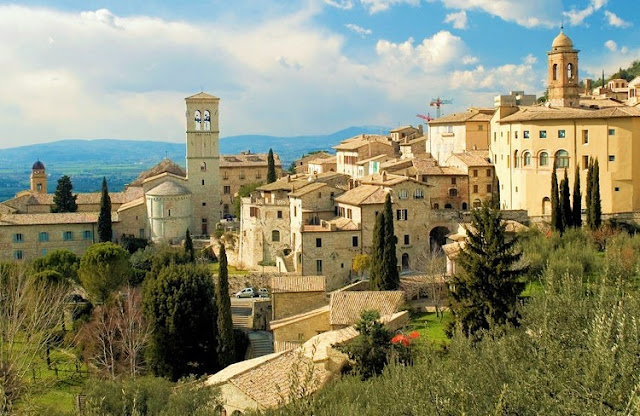Outside the walls of Assisi
Assisi out stands within Umbria's region, in Italy. It's name comes from the word "asio" which means hill. This village is located on the hillside of Mount Subasio, and all things speak to us about the saint, even those that do not have much to do with him. Assisi is continuously visited by loads of pilgrims who want to know the places where Saint Francis was born, lived and died.
Assisi and all of its territory has been included in the list of World Heritage Sites. For Unesco, it constitutes a unique example of historical continuity, of a sanctuary city, from its Umbro-Tuscan and medieval origins until now.
The World Heritage Committee has also included the Basilica and other Franciscan places on its list because they represent a set of masterpieces of human creative genius and a fundamental reference for the history of art in Europe and in the world. Specifically, the Basilica of St. Francis is defined as an extraordinary example of a type of architectural ensemble that has influenced the development of art and architecture.

Celebrated on October 4 as the patron of Italy, St. Francis of Assisi, preacher of a humble and poor lifestyle is the most beloved saint of the Italians. In the city of Umbria, the Basilica dedicated to the saint guards the remains of the "poor of Assisi" and is the goal of thousands of pilgrims.
Being the birthplace of the Franciscan order, since the Middle Ages Assisi has been associated with the cult and diffusion of the Franciscan movement in the world, thus focusing on a message of peace and tolerance even for other religions.

Assisi is a medieval town in Perugia, Italy, in a region known as Umbria, on the western flank of Monte Subasio. Regarded as the birthplace of St. Francis, who founded the Franciscan religious order in this town in 1208, and also St. Clare, the founder of the Poor Sisters, which later became the Order of Poor Clares after her death.
Francis died at the age of almost 44 years and only two years later, on July 16, 1228, the solemn canonization of Assisi took place. On the same day the pontiff Gregory IX laid the first stone of the future Basilica, destined to become the mother house of the Franciscan order.
However, the intention of the designers is not clear. In fact, until now critics have failed to interpret the stylistic disagreement between the lower Church and the upper Church.

One hypothesis argues that the sanctuary was thought from the beginning as a two-story church, in which the lower part (intended to accommodate the remains of St Francis) would have been the memorial church, while the upper one would have served for liturgical ceremonies: in fact, in the apse the papal throne is erected and the same pope is the bishop of this Church. The Lower Church, on the other hand, assumes the typical function of "crypt", that is, the mausoleum erected on the tomb of the saint, as in the old paleochristian temples.
The Sanctuary of Assisi is one of the oldest existing Gothic churches in Italy and has a spectacular mural decoration with frescoes by Ciambue, Giotto, Simone Martini and Pietro Lorenzetti.
No other church can, from this point of view, confront the Basilica of Assisi.






Comments
Post a Comment